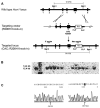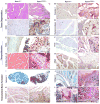An Acvr1 R206H knock-in mouse has fibrodysplasia ossificans progressiva
- PMID: 22508565
- PMCID: PMC3556640
- DOI: 10.1002/jbmr.1637
An Acvr1 R206H knock-in mouse has fibrodysplasia ossificans progressiva
Abstract
Fibrodysplasia ossificans progressiva (FOP; MIM #135100) is a debilitating genetic disorder of dysregulated cellular differentiation characterized by malformation of the great toes during embryonic skeletal development and by progressive heterotopic endochondral ossification postnatally. Patients with these classic clinical features of FOP have the identical heterozygous single nucleotide substitution (c.617G > A; R206H) in the gene encoding ACVR1/ALK2, a bone morphogenetic protein (BMP) type I receptor. Gene targeting was used to develop an Acvr1 knock-in model for FOP (Acvr1(R206H/+)). Radiographic analysis of Acvr1(R206H/+) chimeric mice revealed that this mutation induced malformed first digits in the hind limbs and postnatal extraskeletal bone formation, recapitulating the human disease. Histological analysis of murine lesions showed inflammatory infiltration and apoptosis of skeletal muscle followed by robust formation of heterotopic bone through an endochondral pathway, identical to that seen in patients. Progenitor cells of a Tie2(+) lineage participated in each stage of endochondral osteogenesis. We further determined that both wild-type (WT) and mutant cells are present within the ectopic bone tissue, an unexpected finding that indicates that although the mutation is necessary to induce the bone formation process, the mutation is not required for progenitor cell contribution to bone and cartilage. This unique knock-in mouse model provides novel insight into the genetic regulation of heterotopic ossification and establishes the first direct in vivo evidence that the R206H mutation in ACVR1 causes FOP.
Copyright © 2012 American Society for Bone and Mineral Research.
Conflict of interest statement
Figures





References
-
- Pignolo RJ, Foley KL. Nonhereditary Heterotopic Ossification: Implications for Injury, Arthropathy, and Aging. Clin Rev Bone Min Metab. 2005;3(3-4):261–6.
-
- McCarthy EF, Sundaram M. Heterotopic ossification: a review. Skeletal Radiol. 2005;34(10):609–19. - PubMed
-
- Forsberg JA, Pepek JM, Wagner S, et al. Heterotopic ossification in high-energy wartime extremity injuries: prevalence and risk factors. J Bone Joint Surg Am. 2009;91(5):1084–91. - PubMed
-
- Davis TA, O'Brien FP, Anam K, Grijalva S, Potter BK, Elster EA. Heterotopic ossification in complex orthopaedic combat wounds: quantification and characterization of osteogenic precursor cell activity in traumatized muscle. J Bone Joint Surg Am. 2011;93(12):1122–31. - PubMed
-
- Potter BK, Forsberg JA, Davis TA, et al. Heterotopic ossification following combat-related trauma. J Bone Joint Surg Am. 2010;92(2):74–89. - PubMed
Publication types
MeSH terms
Substances
Grants and funding
LinkOut - more resources
Full Text Sources
Other Literature Sources
Molecular Biology Databases
Miscellaneous

